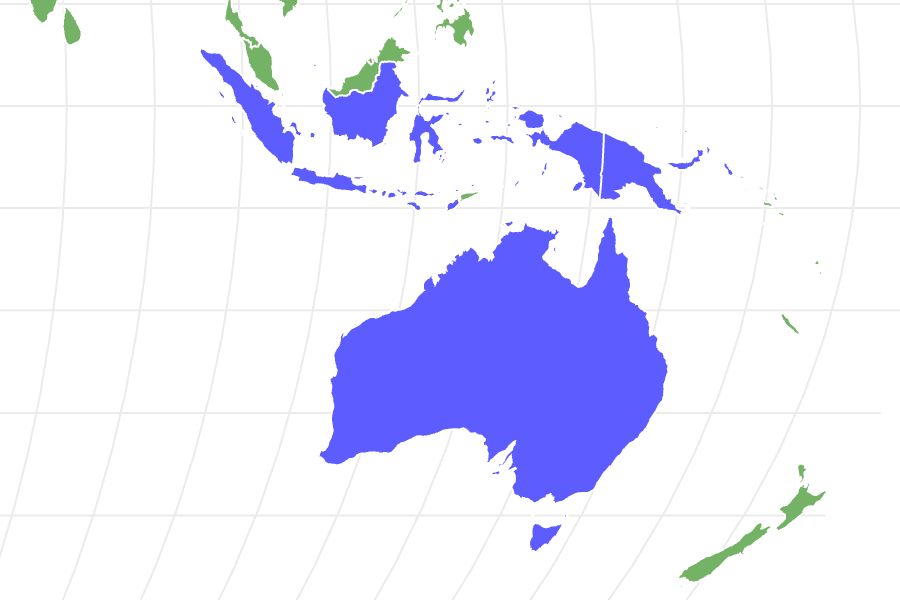Amethystine Python (Scrub Python)
Simalia amethistina
Their milky-iridescent scales have a purplish hue in the light, reminiscent of the gemstone.
Advertisement
Amethystine Python (Scrub Python) Scientific Classification
- Kingdom
- Animalia
- Phylum
- Chordata
- Class
- Reptilia
- Order
- Squamata
- Family
- Pythonidae
- Genus
- Simalia
- Scientific Name
- Simalia amethistina
Read our Complete Guide to Classification of Animals.
Amethystine Python (Scrub Python) Conservation Status
Amethystine Python (Scrub Python) Facts
- Prey
- bats, rats, possums, wallabies, birds, cuscus
- Name Of Young
- Neonate, hatchling, snakelet
- Group Behavior
- Solitary except during mating season
- Fun Fact
- Their milky-iridescent scales have a purplish hue in the light, reminiscent of the gemstone.
- Most Distinctive Feature
- Iridescence in the sun
- Distinctive Feature
- Large size - up to 28 feet long.
- Other Name(s)
- Scrub python
- Litter Size
- 4-21
- Diet for this Fish
- Omnivore
- Lifestyle
- Nocturnal
Amethystine Python (Scrub Python) Physical Characteristics
- Color
- Brown
- Grey
- Yellow
- Black
- Gold
- Orange
- Skin Type
- Scales
- Lifespan
- 20+ years
- Venomous
- No
- Aggression
- Medium
View all of the Amethystine Python (Scrub Python) images!
The amethystine python is one of the six biggest snakes in the world when measured by weight or length.
Found in Australia, Indonesia, and Papua New Guinea, this species has a milky-iridescent sheen across its scales, giving it a purplish hue. The scrub python is popular as a pet because of its size and beauty; yet, wild individuals often cause havoc in residential areas.
Amazing Facts About the Amethystine Python
- Scrub pythons are known troublemakers in Australia, where they sometimes “rampage” through houses, knocking over things as they go.
- Amethystine pythons are called scrub pythons in Australia, where they are the longest snake on the continent.
- The longest verified amethystine python measured 23.6 feet long, according to the Guinness Book of World Records.
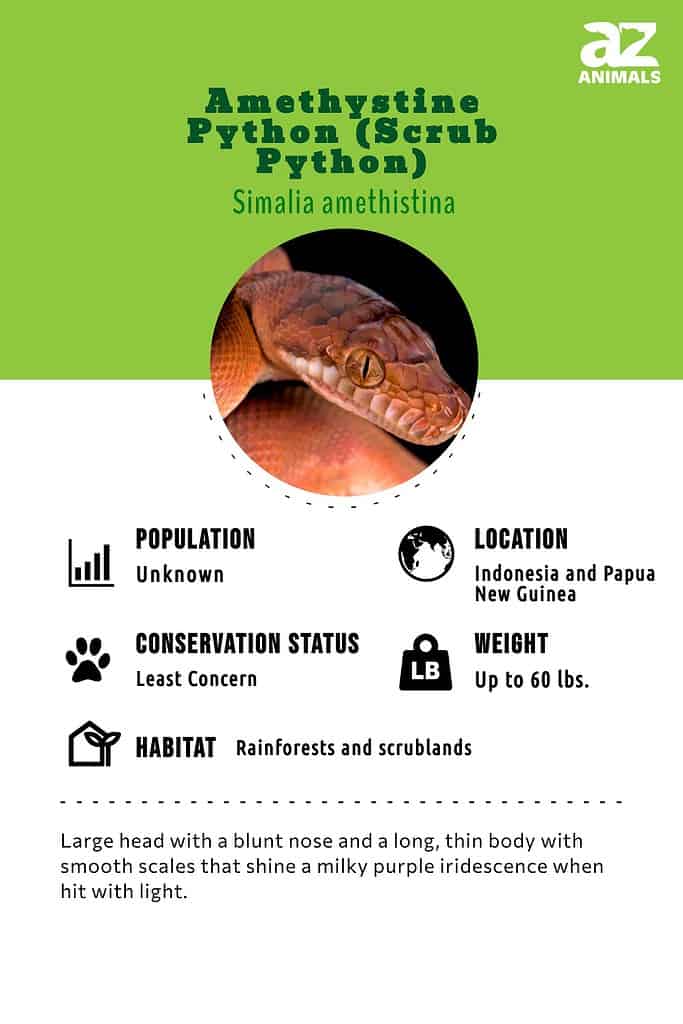
Where to Find Them
The amethystine python is native to the island of New Guinea and its surrounding islands and northeastern Queensland in Australia. The snake hunts by waiting patiently for its prey, and rapidly striking as the animal passes by, once it has a potential meal in its mouth, it wraps several coils around its prey and constricts it until the heart stops.
This species prefers grasslands, rainforests, and shores near water bodies – they are excellent swimmers and traverse waterways to get where they want to go. However, they are also pretty common in suburban neighborhoods and regularly make the news for being in yet another compromising position. They eat a variety of small animals including bats, rats, birds, possums, and others are part of their diet. Larger individuals frequently wait by water sources for cuscus and wallabies that come for a drink of water.
Reproduction
Mating season begins in July and runs through early September. Snakes come together in groups of one or two females with several males competing for breeding rights. The males wrestle and fight, but there aren’t usually any injuries – it’s all posturing to impress the females.
A few weeks after mating, females lay a clutch of up to 21 eggs. They incubate them by coiling around the eggs until they hatch about three months later. Until the eggs hatch, the mothers only leave to bask and do not eat again until after the eggs hatch.
When they’re young, amethystine pythons climb trees for rest and prey. By the time they grow to about six feet, they’re more likely to be living a terrestrial lifestyle.
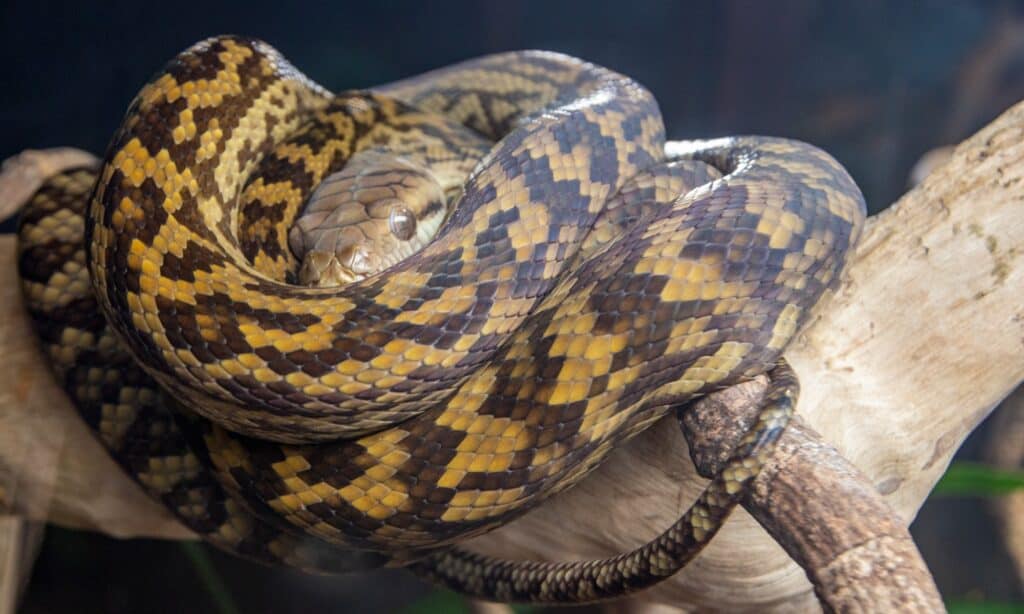
Young scrub pythons spend a lot of time as arboreal snakes.
©iStock.com/Brooke Ottley
Scientific Name and Classification
Amethystine pythons were once the type species for a group of five snakes that scientists believed were subspecies of amethystine pythons. They classified them all under the Morelia genus until a group of biologists delved deeper, using genetic sequencing and morphology.
Their research revealed that they are genetically distinct and deserving of full species status. What they wound up with were five different species, and moved them to the Simalia genus.
Their specific and common names are references to their scales that are reminiscent of an amethyst gemstone in the right light. The Australians call them scrub pythons and in some areas of New Guinea, they’re known as sanca permata.
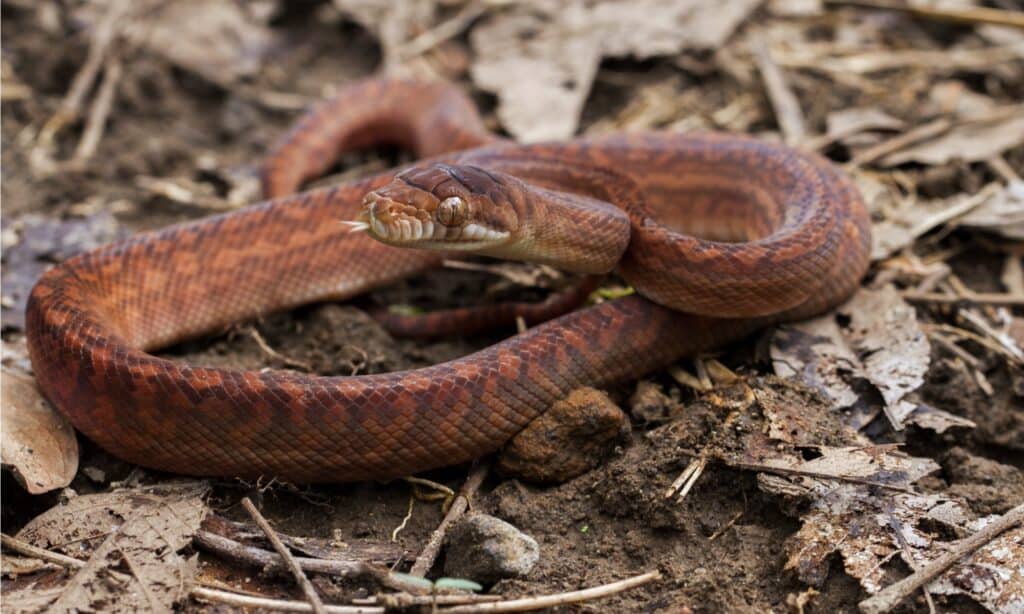
Amethystine pythons’ scales are reminiscent of an amethyst gemstone in the right light.
©iStock.com/dwi septiyana
History and Evolution
Like other snakes, pythons’ early ancestors were actually legged reptiles, similar to lizards and even more aquatic-based reptiles. Eventually, they lost their legs or became vestigial, as they became more and more unused. There are benefits of being extremely low to the ground when your prey is on that level!
While pythons were classified with boa snakes in the past, modern research has shown that they are separate due to convergent evolution in different parts of the world. Some of the major differences are that boas give birth to live young, and pythons lay eggs. Pythons also have their heat-sensing pits on their labial scales, and boas have them in between their labial scales.
Population and Conservation Status
Due to its widespread occurrence, the IUCN Redlist of Threatened Species classified the amethystine python as “Least Concern.”
Given that they reproduce easily and don’t have any significant ecological threats, amethystine pythons are in a good position. Papua New Guinea and Australia restrict any export of native animals, yet outside of those countries, they’re collected and exported as part of the pet industry. At the current levels of collection and trade, the snakes appear to be maintaining their population without difficulty.
Appearance and Description
This large constrictor can reach 24 feet long, but most individuals average 8-14 feet long. The amethystine python is a surprisingly thin species for its length and most 12-foot-long snakes only weigh about 10-15 pounds. Its head is large and elongated with a blunt snout, shield-shaped scales on top with elliptical pupils. Like most pythons, it has heat-sensing pits. These are located near its snout and along the lower rear labials.
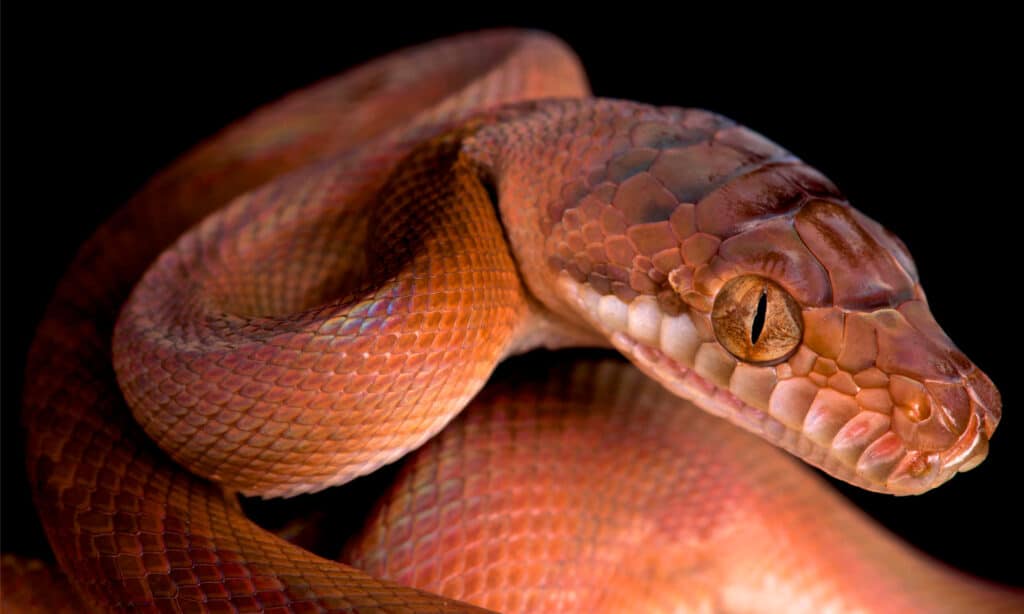
Amethystine pythons are prized for their size and beautiful colors.
©iStock.com/reptiles4all
Its base color ranges from olive green to yellowish-brown with dark brown or black splotches, bands, and/or streaks. The most distinctive thing about its coloration is the effect of light on its scales. The amethystine python is stunning, its scales shimmer with a milky purple iridescence.
How Dangerous Are They?
They’re not venomous, so the danger of an envenomation doesn’t exist with this species. However, their size makes them potentially dangerous to pets and small children. Amethystine pythons sometimes attack pets and livestock, and a small enough child could be at risk. However, most encounters of this nature happen away from cities.
The snakes are opportunistic and go where they think food or a mating opportunity is. Confrontations with these snakes are usually because a person has harassed one, but not always. They can be crabby, and Australians say that amethystine pythons are generally “grumpy snakes.”
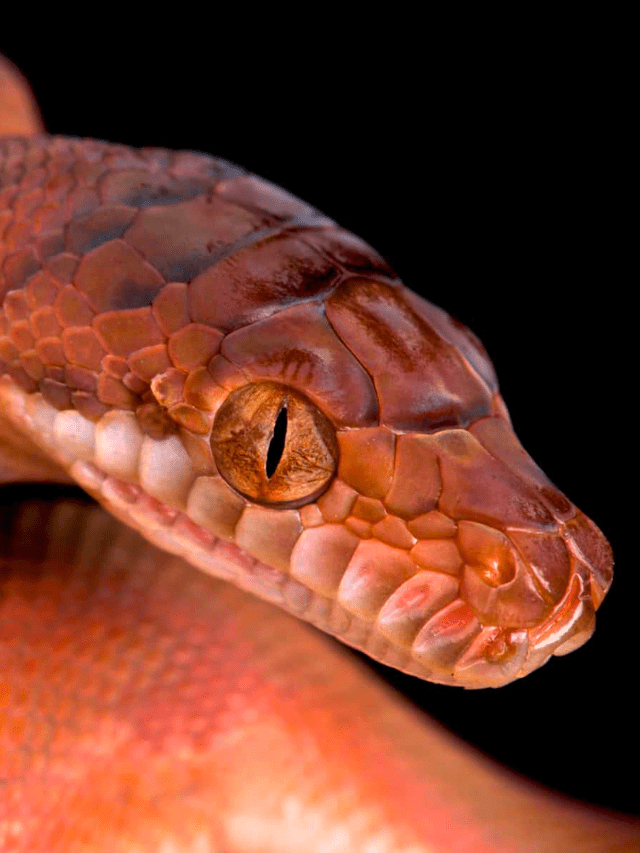
Young amethystine pythons often have a brick red base color.
©reptiles4all/Shutterstock.com
Behavior and Humans
This species doesn’t seem to have any problems being near people or suburban areas; there are several news reports about them showing up in houses, pools, and more. The biggest threat these huge snakes face is being in the wrong place at the wrong time. They are either killed by someone out of fear or run over by a car. They are just as likely to visit suburbia as they are to stay in the rainforest or scrubland.
Antics aside, amethystine pythons are beautiful and generally easy to keep, if you have enough room for a 10-foot-long python.
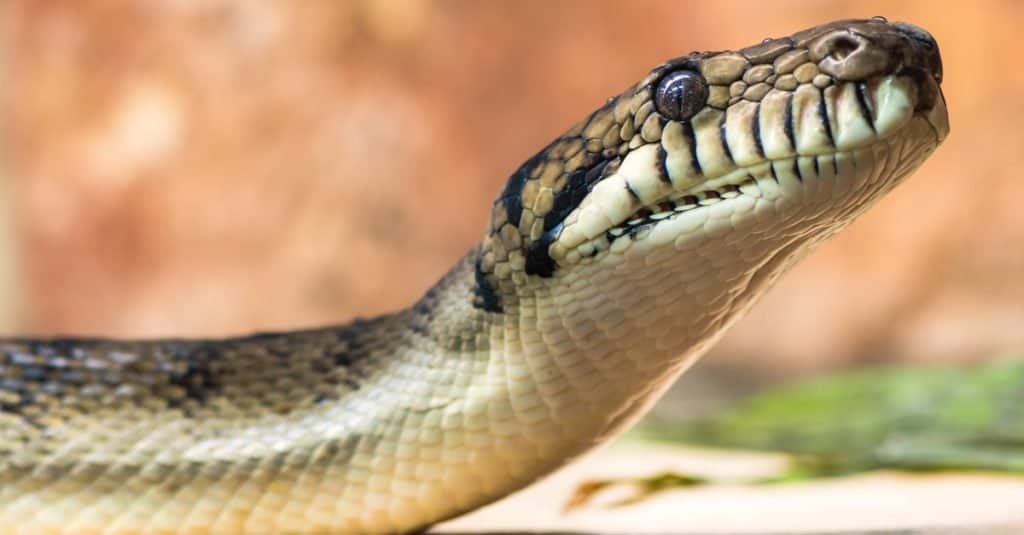
Amethystine Pythons are very good swimmers and will travel by water when it is required.
©IanRedding/Shutterstock.com
Amethystine Python (Scrub Python) FAQs (Frequently Asked Questions)
Are amethystine pythons venomous?
They’re not venomous, but their size can make them dangerous to children and pets.
How do amethystine pythons hunt?
These snakes prefer to sit and wait for their food – they’re ambush predators that use their natural camouflage to their advantage.
Are amethystine pythons aggressive?
They can be feisty, especially the wild-caught individuals. As hatchlings, they’re afraid of everything and are more likely to bite. Captive-bred adults can be pretty easy to handle, if properly socialized.
Where do amethystine pythons live?
They inhabit areas of northeast Queensland, Australia, Indonesia, Papua New Guinea, and many surrounding islands of New Guinea.
What do amethystine pythons eat?
They feast on warm-blooded prey. Anything from bats and rats, to birds, possums, wallabies, and cuscus can be on their menu.
Thank you for reading! Have some feedback for us? Contact the AZ Animals editorial team.
Sources
- Reptarium, Available here: https://reptile-database.reptarium.cz/species?genus=Simalia&species=amethistina
- Amethystine Python | Bristol Zoo, Available here: https://bristolzoo.org.uk/explore-the-zoo/amethystine-python
- Amethystine Python | IUCN Redlist of Threatened Species, Available here: https://www.iucnredlist.org/species/177501/1489667
- Wood, Gerald L | The Guinness Book of Animal Facts, Available here: https://archive.org/details/guinnessbookofan00wood/page/109/mode/2up?q=scrub+python
- Harvey, Michael B.; Barker, David G.; Ammerman, Loren K.; Chippindale, Paul T. (2000). "Systematics of Pythons of the Morelia amethistina Complex (Serpentes: Boidae) with the Description of three new Species". Herpetological Monographs. 14: 139–185., Available here: https://www.jstor.org/stable/1467047

